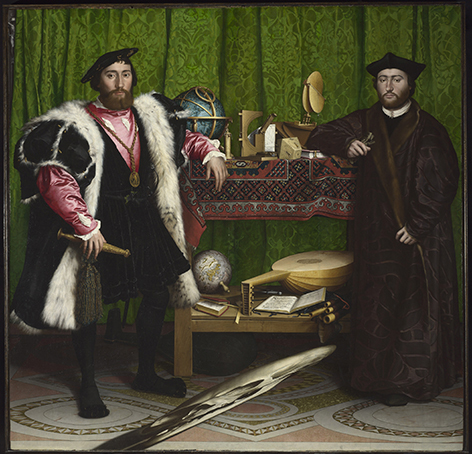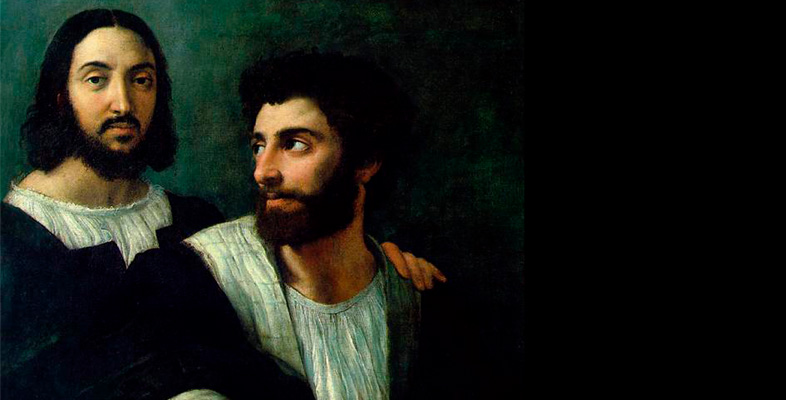1.5.1 Greenblatt on Holbein’s Ambassadors
First, we will look at the image that stands at the centre of Greenblatt’s text (Greenblatt, 1980). This extraordinary double portrait in the National Gallery in London has attracted much attention in the fields of art history, philosophy and psychoanalysis, and has been the focus of landmark critical texts about subjectivity.
The portrait, painted in 1533 while Holbein was serving as court painter of King Henry VIII, shows two French ambassadors to England: Jean de Dinteville on the left and Georges de Selve on the right, both in their twenties at the time. They stand above a cosmati marble floor – modelled on the one at Westminster Abbey – in front of a table laden with musical and scientific instruments. The celestial and terrestrial globes, mathematics text, lute, quadrant, and other objects depicted in vividly realistic detail behind them belong to the disciplines known as the quadrivium, the arts of Mathematics, Geometry, Astronomy and Music. The other disciplines taught in universities at the time were part of the trivium, Grammar, Logic and Rhetoric, which, Greenblatt suggests, were represented by the ambassadors themselves. Below, cutting diagonally across the floor, is the famous skull in ‘anamorphic’ perspective (a form of extreme foreshortening that makes the image readable only from a side view). This clever piece of painting only reveals its true identity when the viewer looks at the picture from the right-hand side.

Spend a few minutes exploring the portrait and the skull; follow the link via the Google Art Project if you want to see the painting in ultra high resolution [Tip: hold Ctrl and click a link to open it in a new tab. (Hide tip)] . Keep in mind that skulls were not an unusual feature of Northern European portraits at the time, but were most often placed on the back of the painting. They appeared there as a reminder of death, a memento mori, to counteract the worldliness of the portrait itself and suggest that the achievements celebrated in the portrait proper would ultimately be wiped away.
Now we will turn to Greenblatt’s discussion of this painting. Greenblatt coined the term ‘self-fashioning’, as he writes in the introduction, to suggest ‘quite simply that in sixteenth-century England there were both selves and a sense that they could be fashioned’ (Greenblatt, 1980, p. 1).
Expanding this further, Greenblatt argued for ‘an increased self-consciousness about the fashioning of human identity as a manipulable, artful process’ in this era (p. 2). Greenblatt finds in the Renaissance or ‘early modern’ period (these terms are used interchangeably in Greenblatt’s work) a new interest in the self and in ‘designating the forming of a self’ (p. 2). Long before the 1980s, the Renaissance had been associated with the cult of the individual and a shift of focus from the after-life of Christian belief to self-celebration in a more secular world. The celebration of ‘great men’ in biographies such as Vasari’s.
